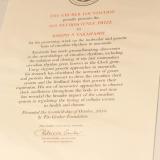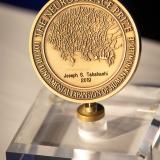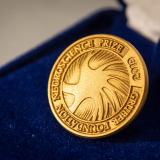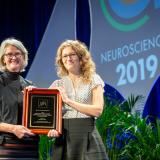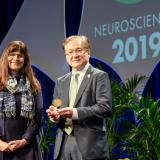2019 Gruber Neuroscience Prize
Joseph S. Takahashi, PhD, of the University of Texas Southwestern Medical Center is perhaps best known for his group’s discovery of the Clock gene in mice, which is a master regulator of circadian rhythms in mammals. Takahashi made groundbreaking discoveries in the neurobiology of circadian rhythms, including the isolation and cloning of the Clock gene. His use of innovative approaches to observe clock oscillations throughout the body in real time has revealed the broader impact of the circadian system in regulating the timing of cellular events in health and disease.
2019 Neuroscience Prize Recipient
Laureate Profile
Joseph S. Takahashi, PhD, of the University of Texas Southwestern Medical Center is perhaps best known for his group’s discovery of the Clock gene in mice, which is a master regulator of circadian rhythms in mammals. Takahashi made groundbreaking discoveries in the neurobiology of circadian rhythms, including the isolation and cloning of the Clock gene. His use of innovative approaches to observe clock oscillations throughout the body in real time has revealed the broader impact of the circadian system in regulating the timing of cellular events in health and disease.
The University of Texas Southwestern Medical Center’s Joseph S. Takahashi, PhD, is one of the most recognized names in circadian biology. Although he had already made significant contributions to the field, the breakthrough that brought Takahashi to fame—the cloning of the mouse Clock gene that encodes a master regulator of circadian rhythms—came in 1997. This advance opened the door to a new realm of studies of circadian biology, including many conducted by Takahashi’s own lab.
Notably, the group followed up on the discovery of Clock by identifying the mouse gene Bmal1, the Clock gene’s partner in regulating circadian biology. The proteins encoded by the two genes, BMAL1 and CLOCK, join to form a complex that regulates the way other genes are activated in a circadian fashion. Takahashi also led his team in discovering a key link between circadian biology in mammals and an important model organism, the fruit fly Drosophila melanogaster, by cloning the conserved Clock and Bmal1 genes in the fly, and separately, by pinning down the genomic location of a mutation in Syrian hamsters known as tau. The tau mutation turned out to affect the gene casein kinase 1 epsilon, which is evolutionarily related to the fly gene doubletime—a regulator of PER, a protein that is also key in mammalian circadian biology and is regulated by CLOCK–BMAL1. This means that despite differences, many molecular aspects of circadian biology are conserved between mammals and flies.
None of these findings would have been possible without Takahashi’s tenacity. At the time Takahashi started looking for the genes behind circadian rhythms in mammals, the proteins PER and TIM were known to regulate circadian biology in flies, but many doubted it would be possible to find genes dictating the complex behaviors of mammals. Even when the group did discover a genetically mutant mouse with an altered circadian rhythm, it wasn’t trivial at the time to determine what gene was altered in the mouse because the mouse genome wasn’t yet available and DNA-sequencing technologies were nowhere near as advanced as they are today. Instead, ten members of the group spent three years using a labor-intensive technique called positional cloning to localize the mutation to the Clock gene. The group then demonstrated that the mutation in Clock was truly the reason for the altered circadian rhythms they observed by putting a wild-type copy of the gene back into the mice, which restored their circadian rhythms to normal.
More recently, Takahashi has become interested in a possible link between circadian rhythms and longevity. In humans and other animals, it has been shown that disrupted circadian rhythms can contribute to various disease states, but the molecular mechanisms are murky. Separately, many studies have found that calorie-restricted diets may increase lifespans in at least some animals. Takahashi noticed that in many of the calorie-restriction studies, feeding time was restricted as well, leading him to wonder whether an interplay between circadian rhythms and feeding explains, at least in part, the differences in longevity. “It's going to take at least one year, maybe two more years, before the experiment’s over,” Takahashi says. “But it's really an interesting time.”
Watch Video
Citation
The Gruber Foundation proudly presents the 2019 Neuroscience Prize to Joseph S. Takahashi for his pioneering work on the molecular and genetic basis of circadian rhythms in mammals.
Takahashi has made groundbreaking discoveries in the neurobiology of circadian rhythms, including the isolation and cloning of the first mammalian circadian rhythm gene, known as the Clock gene. Using elegant genetic approaches in mammals, his research has elucidated the networks of genes and proteins that interact to drive the circadian clock system and the feedback loops that govern their expression. His use of innovative approaches to observe clock oscillations throughout the body in real time has revealed the broader impact of the circadian system in regulating the timing of cellular events in health and disease.



